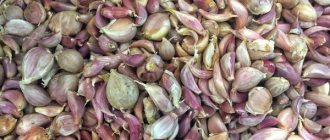Vegetable growing » Garlic
0
2013
Article rating
Kira Stoletova
Have you decided to create a new beautiful flowerbed at your summer cottage and don’t know what seedlings to choose for it? Plant decorative garlic - this plant will not only delight you with its beautiful and delicate flowers that will perfectly decorate your area, but will also surprise you with its taste.
Features of decorative garlic
What is the name and appearance of decorative garlic?
Table garlic belongs to the genus Allium, which has more than 900 species growing on all continents. The word "Allium" means "onion" in Latin. Therefore, one can often observe confusion in names when describing decorative garlic. In the caption under the photo it is often called an onion. From a biological point of view, the latter is true. But the tradition of the Russian language divides the representatives of the genus into garlic and onions. The latter should have a multi-layered bulb and feather tubes. The first is distinguished by a dense, almost monolithic tuber and flat, sword-like or belt-shaped leaves.
The color of the corollas among representatives of the genus is very diverse. It happens:
- yellow;
- white;
- lilac;
- pink;
- burgundy;
- dark purple;
- blue
Also, not all onion inflorescences look like balls. In some species they look more like disheveled umbrellas, in others they look more like a cluster of bells.
When choosing ornamental onion plants, you will have to focus on the first word in the name of the species - “Allium”. And then you need to decide which type of decorative garlic in the flowerbed is preferable. The bow family provides a wide range of choices for the designer.
Inconspicuous varieties
It's impossible to forget about the rather inconspicuous garlic, which has green onion-like leaves and small, pale pink or white flowers. They bloom from summer to autumn:
- Allium ursinum (bear's onion or wild garlic) – white flowers;
- Allium sibiricum (Siberian onion or speedoda) - blooms with dark purple flowers;
- Allium karataviense (Karatavi onion) – white or light purple;
- Allium tuberosum (Dungan onion) – white;
- Allium thunbergii (thunberg garlic);
- Allium cernuum (bent onion) – flowers in white;
- Allium stellatum (star garlic);
- Allium unifolium (one-leaf onion);
- Allium amplectens (covering onion) – triangular in shape,
- Allium triquetrum (triangular onion).
Some varieties are nicknamed weeds due to their uncontrolled spread.
How decorative garlic blooms
Flowering lasts about 30 days. A mandatory feature of all bows is the peduncle arrow. It is on it that the inflorescence of any type develops.
All bulbous plants are suitable for forcing, and garlic is no exception. Thanks to this, flowers can be obtained at almost any time of the year. As long as the plant is warm enough. Accordingly, by planting garlic heads at different times, you can get flowers throughout the entire growing season. And in a greenhouse or room - even in winter. But normally, onions bloom in the summer: from June to August.
The table shows the flowering times of the most popular ornamental species of the Onion genus, immediately planted in the ground.
Reproduction
In the fall, when the inflorescences dry out, large clusters of garlic can be dug up, divided, and planted in another place.
Some garlic, such as A. sphaerocephalon, A. roseum and A. vineale, produce small bulbs at the head of the inflorescence. Separate them, put them in a box with soil and compost, gently press them into the soil, cover them lightly and water them.
You can also sow seeds, but it is not clear how the hybrids will perform. Ripe seeds are sown immediately after harvest or stored in the refrigerator until spring. The minimum germination temperature is 13 degrees. The seedlings do not repeat the characteristics of the mother plant, and we get bulbs ready to flower in about 5 years.
Types of decorative garlic
Ornamental garlic can be a biennial or perennial plant. The only rule: there are no annuals. At the same time, for some reason table species are classified as “scenery”. At the same time, among garden ones you can find rather inconspicuous specimens, differing only in the size of the heads. So we must take into account that the division into “edible” and “decorative” species in the case of the Onion genus is very arbitrary. Theoretically, decorative ones include:
- aflatun (Allium aflatunense);
- Dutch (Allium hollandicum);
- gigantic (Allium giganteum);
- bowed (Allium cernuum);
- Christoph (Allium cristophii);
- Karatavi (Allium karataviense);
- daffodil (Allium narcissiflorum).
Another very interesting species is not officially classified as decorative, but it is often grown in a flower bed due to another property. This is Chinese allspice/branching garlic(Allium ramosum).
Aflatunsky
Perennial. It got its name from the Aflatun Pass in Kyrgyzstan. The tuber is ovoid, 2-6 cm in diameter. The leaves are rosette, belt-shaped, up to 60 cm long and 2-10 cm wide. The color is bluish. The peduncle is hollow and powerful. Height 80-150 cm. The base of the stem is surrounded by leaf sheaths. The inflorescences are almost spherical umbrellas, light purple. Blooms in May-June, bears fruit in August.
Aflatun onion is often confused with Dutch and gigantic onions
Dutch
Also a perennial from among the large decorative garlics. The number of narrow, but not long, basal leaves can reach 15. The peduncle is very powerful, up to 2 m high. The inflorescence is spherical, densely purple or white in color.
The diameter of the inflorescences of decorative Dutch garlic is 25 cm
Gigantic/giant
Perennial large-leaved species. A native of Central Asia and the Middle East. Grows in soft soil in the lower belt of mountains. The main purpose is to decorate a flower bed.
The leaves of decorative giant garlic can be eaten in the same way as table varieties. If a recipe for a dish calls for green “feathers,” you can use greens from a flower bed.
The diameter of the ovoid bulb is 2-4 cm. The height of the peduncle is 80-150 cm. The width of the strap-shaped leaves of a bluish color is 5-10 cm. The length is usually 2-3 times shorter than the stem. The inflorescence is dense, spherical. The color of the corollas is light purple.
Giant garlic can easily be confused with Aflatun garlic, as they are most likely close relatives
Bowed
Perennial wild plant of North America. Habitats: prairies, dry forests and scree.
In its original state, the plant is very inconspicuous. But breeders took it upon themselves, developing several varieties of ornamental garlic for growing in a flower bed in the garden.
The bulb is conical. With a diameter of 15 mm, its length is up to 5 cm. The leaves are flat and narrow. Width 2-4 cm and length up to 30 cm. Rosette. The length of the peduncle is up to 0.5 m. The stem ends with an umbrella bent down with flowers of white or pink color. Flowering time is July-August.
Comment! All parts of the plant are edible, but they have an onion-like smell rather than garlic.
Breeders took up bowed garlic, developing several varieties, including “Purple King”
Christophe's onion/garlic
Powerful, relatively low-growing, perennial plant. The distribution area is mountainous Turkmenistan, northern Iran and Central Türkiye. Grows in the lower mountain zone on soft slopes.
The tuber is spherical, diameter 2-4 cm. The number of rosette leaves is 3-7, their width is 5-25 mm. Flat. The color is bluish-green or gray. There are hard, sparse bristles on the edges.
The peduncle is very powerful. With a height of 15-40 cm, its diameter is 5-15 cm. It is approximately equal in length to the leaves. The inflorescence is 20 cm in diameter. It can be spherical, but more often hemispherical. The color of the flowers is purple or pink-violet. A characteristic feature of this type of decorative garlic is star-shaped flowers with narrow petals. Flowering in June.
Comment! The leaves die off after flowering.
Christophe's garlic can be propagated by daughter bulbs or seeds. Its main purpose on the site is to decorate the flower bed.
Christophe's garlic looks good as a border plant if planted fairly densely.
Karatavsky
Endemic to the Pamir-Altai and Tien Shan. The name comes from the Karatau ridge. Prefers to grow on mobile limestone screes of the lower mountain belt.
The bulb is spherical. Diameter 2-6 cm. There are usually two leaves, but there may be three or one. The shape is lanceolate, oblong or almost spherical. Leaf width is 3-15 cm. The peduncle is short: from 10 to 25 cm. It can be half immersed in the ground. The stem is shorter than the leaves. The inflorescence is spherical, dense. The color is white or light pink-violet.
Comment! Thanks to its unusual leaves, flowering Karatavi garlic looks very decorative when planted in small groups.
Tulip-like leaves of Karatav garlic in combination with balls of inflorescences create cognitive dissonance
Narcissus flower
Homeland - the mountains of Spain, the south of France and the north of Italy. Herbaceous perennial, only 10-40 cm high. Leaves are lanceolate-linear, bluish in color. The flowers are large: 1-1.2 cm long. The wild form has a pink corolla. The inflorescences are a drooping umbrella of hemispherical or almost flat shape. Both the appearance in the photo and the name of garlic indicate that its main use is decorative.
Brighter decorative varieties have already been bred from the wild form of narcissus garlic.
Fragrant
This species has many names, the origin of which is often associated with Latin names. That is, “tracing paper”. Of the Latin ones, the two most commonly used are: Allium odorum - fragrant onion/garlic and Allium ramosum - branched onion/garlic. Other Russian names:
- wild;
- Chinese;
- odorous;
- Tatar.
There are two more almost forgotten Russian names: lousy onion and steppe garlic.
Comment! In Kazakhstan it is often called “Dzhusai”, but originally this was the name of another species, Chinese leek (Allium tuberosum).
For marketing purposes, the plant was often called Chinese garlic to add a touch of exoticism. This is partly true, since the mountains of Mongolia and China are considered the birthplace of fragrant garlic. It was brought to Central Asia, Western and Eastern Siberia by nomadic tribes.
This is a perennial frost-resistant plant. Although, in comparison with its “brothers”, Chinese garlic is considered heat-loving. Moreover, even with light snow cover, the bulb can overwinter at a temperature of -45 °C. Jusai is capable of growing both in the shade and in well-lit areas.
The Chinese garlic bulb is not very suitable for food due to its size: 8-15 mm in diameter. It is elongated and goes into the rhizome. The leaves are long, from 35 to 60 cm, but narrow - 8-12 mm. Belt-shaped, fleshy. The color is dark green. There is a waxy coating. The number of leaves per plant is 6-12 pieces. Total weight 35-70 g.
Comment! It is the leaves that are eaten. They have an onion-garlic taste.
The height of the peduncle is 60-70 cm. The inflorescence is a thick ball. Flowering period July-August. In the photo, Chinese garlic does not look special; it was included in the decorative category not for its flowers, but for its aroma. Its feature, which is absent in other types of onions, is a pleasant floral smell.
Jusai is drought-resistant, but beautiful leaves can only be obtained with good watering. Another advantage is that it is undemanding to the soil. He is not afraid of even slightly salted soil.
Chinese garlic is cultivated for its leaves, which must be cut 3-4 times during the growing season.
A little history
Garlic was primarily of interest to Russian botanists, who collected specimens in Central Asia and created the first collections in the Botanical Garden of the Imperial Palace in St. Petersburg. British botanists immediately took up the baton and showed the world new, attractive species.
Planting and caring for decorative garlic
Even decorative garlic is in fact a vegetable crop with the same requirements for “neighbors” and predecessors as the table variety. Plants prefer dry, sunny places with loose soil. They are usually undemanding to soil quality and can grow where other flowers die.
Important! You cannot plant decorative garlic where nightshades grew last year.
When to plant decorative garlic
The decorative variety of garlic, like table garlic, reproduces by seeds and daughter bulbs. The latter will overwinter well in the soil if you do not dig them up. But in the spring you will still have to divide the planting material, since otherwise the garlic will quickly degenerate. Whether or not to dig up bulbs in the fall depends entirely on the wishes of the owner of the site. But it’s better to plant them in a new place in the spring, after the frosts have ended. The advantages of vegetative propagation are that garlic will bloom within the first year after planting.
When deciding to propagate the plant by seeds, planting decorative garlic is carried out in the fall. They are planted 1.5 months before the onset of frost.
When planting seeds in the spring, they are pre-soaked and germinated. Decorative garlic can be planted in early spring, as it is not afraid of frost.
Seeds of ornamental species from the genus Onion can look different: like small heads or black grains
But since garlic is often understood as a decorative onion, the seeds may look different, be dense and black. Such fruits are called “chernushka”.
Requirements for place and soil
Almost all types of onions are steppe plants. The mountain slopes where some of them grow are treeless and differ from the steppe only in slope. Therefore, when choosing a place to plant decorative garlic, you need to take into account the amount of sunlight falling there. These plants can withstand even summer afternoon sun.
Comment! Their winter hardiness is also excellent. Being wild plants, they can overwinter at a temperature of -30 °C, without needing shelter.
Decorative garlic is also undemanding when it comes to soil. But it does not like acidic or waterlogged soil. The soil must be alkaline or neutral. Prefers to grow in loose soil that drains water well. The flower is drought-resistant, and a slight lack of moisture is better for it than its excess.
How to plant decorative garlic
Before planting, the soil must be prepared in order to obtain strong plants with good inflorescences in the spring. The soil is prepared in advance, even in the summer. They dig it up and add nutrients:
- 20 g superphosphate;
- 15 g potassium salt;
- 10 kg of humus.
All standards are given per 1 sq. m.
Important! If the flowerbed is laid out in place of the beds, you cannot plant garlic in the place of tomatoes, potatoes or cucumbers.
These plants have too many common diseases.
By selecting species with different colors of inflorescences, you can create interesting compositions
When planting decorative garlic cloves, make grooves about 10 cm deep in the soil. The cloves are “placed” vertically and sprinkled with soil. If garlic is planted in the fall, it will have to be covered with peat during frosts. Planting is carried out no later than 1 month before the onset of cold weather. But it is better to plant daughter bulbs in the spring, since garlic can begin to grow in the fall. Then he will die in winter.
It is better to plant seeds in the fall 1.5 months before the onset of cold weather. They should not be soaked. Over the winter, the grains will undergo natural stratification, and in the spring they themselves will become wet in melt water. Only healthy and whole seeds are selected for planting. They are sown to a depth of 2-3 cm. Shoots appear after a month. “Chernushka” and “vozdushka” grow slowly.
Comment! Garlic grown from seeds will bloom only in the second year.
Aftercare
Although decorative garlic is unpretentious, it also requires some care. After sprouts appear, it must be regularly weeded to remove weeds. Watering is required only four times per season, unless the year is dry. Otherwise, you will have to water more often depending on the need for water.
The soil must be loosened regularly, especially after heavy rain. To obtain a strong central peduncle and a beautiful large inflorescence, it is necessary to remove all lateral arrows if they appear.
Otherwise, no special care is required. Only standard pest and disease control for all flowers.
If not properly cared for, the leaves quickly turn yellow and the plant loses a significant part of its attractiveness.
Planting spring garlic in open ground
What time to plant
To propagate spring garlic, only its cloves are used; they are planted in open ground at the beginning of spring, immediately after the soil on the site has warmed up to 5–7 degrees. The formation and growth of the root system and foliage is observed at a temperature of 4–10 degrees. If garlic is planted later than necessary, this will have a negative impact on the yield. The fact is that when the air and soil warm up to higher temperatures, because of this the bushes stop developing and the bulbs stop forming. If you care for garlic correctly and provide it with suitable conditions for growth, then growing it will be quite simple.
Site preparation
Cultivated, nutritious, neutral loamy or sandy loam soil is suitable for cultivating such a plant. The site should be sunny and have reliable protection from the cold north wind. Low-lying areas, where the snow cover does not melt for a long time and there is stagnation of water, are least suitable for growing garlic.
They begin to prepare the area for planting such a crop in the autumn. To do this, the soil is dug up to the depth of a spade bayonet, and 3 tbsp is added to it. wood ash, 5 liters of compost or humus and 10–15 grams of complex mineral fertilizer per 1 square meter of land. In the spring, before planting, the surface of the bed must be leveled with a rake.
The best predecessors
Garlic grows best in areas where cabbage, cucumbers, squash, zucchini and other pumpkin crops, grains and legumes, as well as herbs were previously grown. The worst places for growing garlic are areas where potatoes or carrots were previously cultivated. And those areas where onions or garlic grew can be used for growing this crop no earlier than after 3 or 4 years.
Since garlic can repel slugs, borers, weevils and other harmful insects, it is recommended to place a bed with it next to roses, gladioli, tulips, strawberries, potatoes, black currants, onions, tomatoes, cucumbers and gooseberries. Remember that if spring garlic is planted near peas, cabbage or beans, it will inhibit these crops.
Which GARLIC to choose for planting for the winter? Spring garlic, winter garlic, overview of varieties.
Landing rules
Immediately before planting, you need to separate the cloves from the bulb. At the same time, it is recommended to plant only medium (3–6 grams) and large (more than 6 grams) slices; they cannot be peeled. Planting material should not be taken from bulbs on which only 2 or 3 cloves are formed, since this is degenerating garlic and is not suitable for propagation. Inspect all the lobules, they should be elastic and not injured.
When there are 30 to 40 days left before planting, whole garlic heads should be buried in the snow or placed on the refrigerator shelf intended for vegetables. Before planting, the prepared cloves are placed for half a day in a disinfectant solution of potassium manganese (1%) or copper sulfate (1%). Instead, the teeth can be placed in a very warm place (40 to 42 degrees) for 8–10 hours. Also, to disinfect planting material, you can use ash lye, to prepare which you need to combine a liter of water with 200 g of ash, the mixture is boiled for half an hour. When the lye has cooled, the teeth are immersed in it for a couple of hours.
To ensure that the first sprouts appear as soon as possible, it is recommended to first germinate the garlic cloves indoors. Teeth covered with scales should be wrapped in a damp cloth and placed in a plastic bag for two or three days.
Garlic must be planted in pre-moistened soil. The surface of the bed needs to be leveled, and then grooves with a depth of 30 to 40 mm are made on it, while the width between them should be from 25 to 30 centimeters. Then the teeth are distributed into them, and the distance between the middle lobes should be at least 8 centimeters, and between the large ones - about 10–12 centimeters. You should not press the slices into the ground, because this has a bad effect on the growth and development of the root system.
Diseases and pests
Basically, garlic gets sick due to being in an environment that is too humid. In the flowerbed it is affected by powdery mildew. The plant begins to wither, light green spots appear on the leaves and peduncle. Eventually, the garlic dries out. This can be avoided by following watering rules and changing the growing location every 3-4 years. It is also necessary to treat the teeth with a fungicide before planting.
During storage, garlic heads are often affected by neck rot. The cloves first become soft, then mold grows on them, and eventually they dry out. This happens due to insufficient drying of the bulbs before storing. As a preventative measure, the harvested garlic is dried in the sun and only then sent for storage.
Ornamental garlic is attacked by garden pests: spider mites, onion flies and onion moths.
These pests are eliminated using insecticides designed to treat garden crops against insects.
Timing and technology of transplantation
Decorative onions are replanted after a year. This need is associated with its root system, which quickly selects from the soil all the nutrients necessary for growth and development.
At the end of autumn, before the planned transplant, the bulbs are dug out of the ground and left for storage in the house. To do this, you need to choose a dark and dry place so that the plant does not begin to germinate prematurely.
With the onset of spring, the soil is loosened and the bulbs are planted on a new plot of land. They can spend one winter in the soil, but after a year they will need to be replanted again. The frequency of “moving” of bulbs does not depend on age.
Ornamental garlic is a specific plant, but interesting both in terms of decorative properties and in its medicinal and taste characteristics. This option is best suited for summer gardeners due to its ease of maintenance, as well as for those whose plot is almost always lit and is rarely shaded by buildings or trees.
Source
Decorative onions are replanted after a year. This need is associated with its root system, which quickly selects from the soil all the nutrients necessary for growth and development.
With the onset of spring, the soil is loosened and the bulbs are planted on a new plot of land. They can spend one winter in the soil, but after a year they will need to be replanted again. The frequency of “moving” of bulbs does not depend on age.
Ornamental garlic is a specific plant, but interesting both in terms of decorative properties and in its medicinal and taste characteristics. This option is best suited for summer gardeners due to its ease of maintenance, as well as for those whose plot is almost always lit and is rarely shaded by buildings or trees.
Ornamental garlic is replanted every two to three years. Grows well after cabbage, cucumbers, not bad after legumes and green manure
And you shouldn’t plant after potatoes, no matter early or late, and tomatoes
How to propagate decorative garlic
Decorative garlic is propagated by seeds and daughter bulbs/cloves. Nigella is harvested after the seed pods turn brown and dry. The inflorescences are torn off, the seeds are husked and dried.
If you choose the method of propagation by daughter bulbs, they must be separated from the mother bulbs in the spring before planting. Otherwise, the small clove will dry out during storage. The head of garlic is dug up, being careful not to damage it. Dry in the sun and lay out in a cool place on straw. Sawdust is not suitable, as too dry ones suck water out of the bulbs. And in damp conditions, garlic can germinate. Another storage method: in hanging bunches.
This is usually how table garlic is stored, but this method is also suitable for decorative garlic.
Features of growing garlic from bulbs
Garlic is considered a perennial (three-year) crop, but is often used as an annual, which is why it gradually degenerates. To avoid this, you need to regularly update the seed.
When planting winter bulbs, leave a few arrows on the sprouts grown from large cloves. Seeds are formed on them - single-toothed ones. When it is time to harvest, the plant is tied into a bundle and hung to dry. During this period, plastic substances flow to the bulbs from the green mass of the plant, promoting growth. After the stems have completely dried, they are carefully separated.
Bulbs are planted both in spring and autumn in pre-prepared soil. They are buried 3 cm, as they are very small. Dig out when the leaves begin to turn yellow. Then they dry it: first for a couple of days in the sun, then under a canopy. One-toothed trees planted in the fall will yield a good harvest with proper care.
The use of decorative garlic
Various types of garlic are often used for garden decoration. There is even a separate category of onion garden called “alaria”. Only representatives of the Onion genus are used in it.
Plants look very good on alpine slides. They are widely used in landscape design, where strict geometric shapes are required. Low-growing decorative onions are often used to decorate borders along paths.
The main advantage of decorative types of onions is that they bloom when other similar plants have already completed their growing season. Therefore, they can be used in popular herb and grain gardens. It is even possible to partially “recreate” steppe expanses or alpine meadows.
Peduncles are used as a cut crop. Ball-shaped inflorescences look good in a bouquet in combination with other garden plants. Green leaves can be used in summer salads.
Is it possible to eat decorative garlic?
All species of the genus Onion are edible. They may differ from table garlic in richness and shades of taste, but otherwise they are very similar. In the regions of origin, they are eaten along with regular garlic.
Comment! Table garlic also has many varieties, varying in severity and size.
Decorative garlic can be eaten in any dish. Add to taste.
The restrictions are the same as in the case of table varieties. You should not eat whole heads of the spice in an attempt to protect yourself from respiratory viruses. Eating decorative garlic helps against diseases in the same way as in the case of table garlic. That is, no way. But you can burn your stomach lining. So everything is good in moderation.
But since decorative onions/garlic generally mean wild species, you need to remember that these plants have a less pronounced taste and smell than garden crops.
Another reason why ornamental varieties are usually not eaten: it is an expensive pleasure to eat planting material. But you may not get the desired effect in the dish.
Growing Garlic Seeds
Growing garlic indoors requires a significant amount of seeds, so instead of cloves, garlic is often grown from seeds. In June, winter varieties begin to form arrows with inflorescences, which are called “bulbs”, and it is from them that seed material is collected. In cold regions, a greenhouse can be used for planting.
For harvesting, it is necessary to select healthy plants; at the moment the inflorescence bursts, the crop is removed from the garden bed and dried. To do this, the plant can be completely pulled out or cut off. Before direct sowing, the bulbs are cleaned, completely removing the inflorescence.
Features of care
Ornamental garlic is not picky, so it is ideal for novice gardeners, as well as summer residents who cannot visit their plot regularly. There are several features that need to be taken into account in order to grow a healthy and beautiful plant.
Watering requirement
Garlic is rarely watered. It has a fairly strong root system that grows deep into the soil and feeds the plant with groundwater. In spring, decorative garlic is watered no more than 2-3 times, as in autumn.
If the summer turns out to be rainy, then this irrigation scheme is suitable for it. If the dry weather drags on for a long time, watering should be done twice a month.
Feeding
Garlic does not need additional liquid fertilizing, but other fertilizers must be added to the soil, especially before transplanting. Best suited for this type of allium are:
- A mixture of humus or peat.
- Wood ash.
- Magnesium sulfate.
What is the difference between spring and winter?
Spring garlic:
- Planted in spring.
- It has a large number of chaotically located lobules (8-20).
- The husk is soft.
Winter garlic:
- Planted in autumn (before winter).
- The bulb has 5-10 large cloves, evenly spaced around the central core.
- The shell of the lobules is hard.
Only the winter variety shoots arrows.
You will find more information about the differences between winter and spring garlic in this article.
Recommendations for planting:
- the bottom of the bed can be covered with newspapers dipped in water, they will not allow weeds to break through earlier in the spring;
- plant with the sharp tail up or the clove on its side;
- sprinkle a layer of humus on top;
- sprinkle it with sand.
Basically, this plant is not picky in its care and does not require special conditions.
Watering should be plentiful, but not too frequent, since excess moisture is harmful to the plant. During the season you need to water it only two or three times.
The optimal temperature for garlic is 20 degrees Celsius.
After a year,
you need to transplant the plant to another place so that it does not become smaller and the flowers are large.
The soil near the garlic must be loosened , especially after heavy watering or rain, so that the soil does not crack. You also need to weed the garlic from weeds that will interfere with its growth.
Garlic fruits will be large if you cut off the first arrows.
It is imperative to feed the plant with wood ash, humus and magnesium sulfate.
Description of the plant
The plant may look different depending on the species. What all plants have in common is small flowers collected in inflorescences, hovering above the foliage on arrows, narrow smooth leaves. Flowering garlic plants are not inferior in decorativeness to bulbous plants, such as pushkinia or daffodils.
Types of decorative garlic:
- Neapolitan. Decorative garlic of this species is distinguished by small but clearly visible white flowers, collected in loose, openwork inflorescences. In the pictures it strongly resembles wild garlic onions, but in reality it is more decorative. Plant height – 15-16 cm;
- Bow Moli. The botanical name of this species is Allium moly, that is, it can safely be called garlic (in Latin, garlic and onion - Allium). Allium Moli is also called "golden garlic" for its very bright yellow flowers. The flowers of Moli garlic are truly so rich in color that they evoke associations with precious metal. The leaves are bluish, long, 4-5 cm wide, flowers 1 cm in diameter are star-shaped, collected in inflorescences of 9-15 pieces;
- Garlic Narcissiflorum. It received this name not for its color, but for the shape of its flowers. The drooping heads of bell-shaped flowers, 1-2 cm long, lilac-burgundy in color, are collected in sparse inflorescences of 5-12 pieces. Peduncles are 10-40 cm long. The leaves are narrow, long, up to 20 cm, and grow luxuriantly. An unusually graceful plant. This garlic with purple flowers will bring spring freshness to any composition;
- The onion-garlic Rocambole is not classified as decorative, but may become so for particularly daring gardeners. Its wide, large leaves are spectacular, and the yield is impressive - the weight of one head can reach 400 g. This garlic has a relatively modest flower. Not bright lilac-pink buds are collected in inflorescences-balls. They look impressive, thanks to the peduncle up to 1 m tall. In some sources, Rocambole may be mistakenly called elephant garlic.
Decorative garlic appearance
How does garlic bloom? Typically flowering lasts about a month. Like any bulbous plant, decorative garlic is suitable for forcing, so you can get flowers in open or closed ground at any time. Standard flowering periods for various types of ornamental garlic
| Name | When can it bloom, flowering period |
| Garlic Neapolitan | Beginning of June – July, 30 days |
| Garlic Moli | Mid-June, blooms for about 30 days |
| Garlic Narcissiflorum | From mid-July to early August, flowering lasts up to 35 days |
| Rockambole | July, flowering lasts about a month |
Landing
Decorative - loves sunlight very much , so the planting site should not be too dark, as garlic will not grow in the shade. The distance between the garlic and the neighboring plant should be more than 20 cm.
You can plant it from seeds.
Sowing is best done in late summer or early autumn .
To get seeds you need to wait until the arrow grows and not cut it off. At the top of the arrow a large ball will form with buds in which the seeds will ripen. They need to be collected and dried. A few days before planting, the seeds should be soaked in wood ash. The seeds that fall to the bottom of the jar can be planted, the rest should be thrown away. This plant needs to be planted in a sunny place, because it does not grow well in the shade and does not like strong moisture.
You can plant them in the place where legumes, cabbage or cucumbers grew. In place of the potato, it can become infected with diseases that affected the potato.
Seeds should be sown in holes up to 3 cm deep. Cover them with a thin layer of sand and peat.
If garlic is planted with bulbs , then the distance between them should be at least 10 cm. This will allow the plant to grow well and the flowers will be large and bright.
The length of the stem and the size of the flower depend on the size of the bulb.
Benefits and harms
The benefits of garlic are explained by its rich chemical composition, which includes a lot of vitamins and microelements.
Garlic has a positive effect on:
- immune system;
- heart function;
- testosterone level;
- purification of blood from cholesterol;
- gastrointestinal tract;
- decrease in blood sugar;
- the rate of regeneration and renewal of cells and tissues.
Harm from using garlic is possible in the following pathologies::
- anemia;
- pancreatitis;
- gastritis;
- haemorrhoids;
- chronic gastrointestinal diseases;
- individual intolerance.
We talked in more detail about contraindications to eating garlic here.
We invite you to watch a video about the benefits of garlic and precautions when consuming it:
Is it possible to grow garlic on a windowsill?
Housewives really like the idea of growing spices, medicinal herbs or spices at home. Garlic is no exception. Growing garlic at home does not require special knowledge or high costs, but has beneficial advantages:
- Obtaining environmentally friendly products;
- The ability to have fresh greens and a constant source of vitamins at any time.
The agricultural technology of growing garlic on a windowsill is not difficult even for those who have never done it before. It is important to choose the right planting material and prepare the necessary materials. The first stage is choosing a garlic variety for home cultivation.











